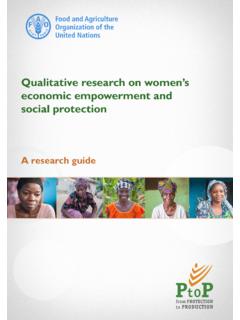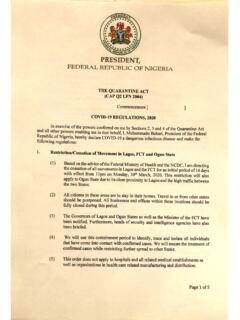Transcription of Promoting Livelihoods and Self-reliance - UNHCR
1 IPromoting Livelihoods and Self-relianceOperational Guidance on Refugee Protection and Solutions in Urban AreasPromoting Livelihoods and seLf-reLianceIIOPERATIONAL GUIDANCE ON REFUGEE PROTECTION AND SOLUTIONS IN URBAN AREAS UNHCR , 2011. All rights and dissemination for educational or other non-commercial purposes is authorized without any prior written permission from the copyright holders provided the source is fully acknowledged. Reproduction for resale or other commercial purposes, or translation for any purpose, is prohibited without the written permission of the copyright holders. Applications for such permission should be addressed to the Education Section of the Office of the United Nations High Commissioner for Refugees ( UNHCR ) at reasonable precautions have been taken by the United Nations High Commissioner for Refugees to verify the information contained in this publication.
2 However, the published material is being distributed without warranty of any kind, either express or implied. The responsibility for the interpretation and use of the material lies with the reader. In no event shall the United Nations High Commissioner for Refugees be liable for damages arising from its of this document can be obtained from:UNHCRD ivision of Programme Support and ManagementOSTS / Livelihood unit Rue de Montbrillant 941202 Geneva, SwitzerlandEmail: Page Photo: Yemen / refugees / Basateen urban area, Aden / Mohammed charges US$ 10 to repair a refrigerator. When I am behind my workbench I put my crutches aside and forget about my disability . With a daily profit of US$ 20, Abdul earns four times the average salary of a Yemeni public employee. / UNHCR / R. Nuri / April 2009 Graphic Design: A. Mannocchi / Rome1 Table of Contents I.
3 II. Overview ..3 III. Objective ..5 IV. Key V. Operational 1. Access ..7 2. 3. Assessment ..11 4. 5. 6. 7. 8. Monitoring and evaluation ..22 9. Handing over ..24 VI. Annex: Indicative List of Livelihood Activities ..27 VII. Livelihoods and Self-relianceOperational Guidance on Refugee Protection and Solutions in Urban AreasPromoting Livelihoods and seLf-reLiance2 OPERATIONAL GUIDANCE ON REFUGEE PROTECTION AND SOLUTIONS IN URBAN AREASACROnymSAGD Age, Gender and DiversityBDS Business Development ServiceCAP Consolidated Appeals ProcessCO Community OrganizationCTA Community Technology AccessILO International Labour OrganizationIP Implementing PartnerICT Information and Communication TechnologyMFI Micro-Finance InstitutionMFT Multi-Functional TeamNGO Non-Governmental OrganizationPIP People, Institutions and ProcessesPRSP Poverty Reduction Strategy PlanPoC Person of ConcernSGBV Sexual and Gender- based ViolenceSWOT Strengths, Weaknesses.
4 Opportunities and ThreatsUNCT United Nations Country TeamUNDAF United Nations Development Assistance Framework3 OveRview The Right to Work is a right established in the Article of the Universal Declaration of Human Rights and in the Article 6 of the International Covenant on Economic, Social and Cultural Rights. It allows men and women of all ages and backgrounds to live in dignity and to become self-reliant. The right to work includes refugees according to Articles 17, 18 and 19 of the 1951 Geneva urban settings, protection and Livelihoods are closely intertwined. Forcibly displaced people need to acquire goods and services, and cash everyday, but many aspects of urban settings make the pursuit of Livelihoods risky. Host government policy often makes it illegal for refugees to work or to own property or businesses.
5 Even in situations where refugees can legally work, access to decent employment continues to be a huge obstacle. Cases of discrimination and harassment by the state (police, immigration authorities) can make it difficult for refugees to move around freely to work or engage in economic activities. Refugees often face greater expenses than other urban poor because of costs associated with bribes, often related to the lack of documentation. Refugees are discriminated against by landlords and employers who often require higher rents or extra fees . Refugees are targeted by criminals, who know they are less likely to seek recourse. The poor are more likely to rely on child labour and to engage in risky coping strategies including illegal and criminal activities such as prostitution and smuggling.
6 Accessing public health and education services may pose a financial burden on refugees that exceed the burden experienced by other urban poor. In many cases financial shocks come in the form of school fees and hospital bills that exceed their monthly income and may indebt them to their community or meeting protection objectives, advocating for livelihood rights and supporting refugees in fulfilling those rights is appropriate and necessary for UNHCR in urban settings for the following reasons: Many refugees come to cities because they possess assets that are more effectively utilized in urban settings than in camps or rural areas. Livelihood programmes promote and preserve the use of skills and assets, which can prevent households and individuals from slipping into poverty, and enables them at the same time to support their own communities.
7 Promoting Livelihoods and seLf-reLiance4 OPERATIONAL GUIDANCE ON REFUGEE PROTECTION AND SOLUTIONS IN URBAN AREAS Increasing the economic capacity of households can promote durable solutions, particularly successful repatriation. Refugees who can build and protect their livelihood assets are more able and more likely to return to their home countries when it is safe to do so. Livelihood programmes that also benefit local populations can address host government concerns about the presence of refugees in cities (economic competition, pressure on resources, etc.) and improve the asylum environment. The pursuit of Livelihoods helps restore the dignity and independence of refugees. This operational guidance to livelihood programming is aimed primarily at UNHCR Field Operations, starting with representatives and senior managers in field operations; at Multi-Functional Teams (MFT ) that include Protection, Programme, Community Services, Field and Livelihoods Officers, where applicable; and at government counterparts and operational and implementing partners, including potential new partners that may include microfinance institutions, the private sector, foundations and academic institutions.
8 Regional representations and decision-makers in headquarters are also guidelines address all urban persons of concern (PoC) currently under UNHCR s mandated and designated responsibility, including refugees, asylum seekers, internally displaced persons (IDP), stateless persons and returnees. The guidelines will specify where and how approaches to different groups vary. For the sake of this document, the term refugee refers generally to UNHCR s populations of concern. While UNHCR is not mandated to support the local population, it is generally acknowledged that they should be included in activities that are planned in areas with a high concentration of operational guidance is based on lessons learnt and good practices gathered across urban operations since 2008. This guidance is complemented by general guidance on Livelihoods , on assessment, microfinance and advocacy for the right to work, available on Livelihoods pages on the Intranet (Protection and Operational themes > Livelihoods ).
9 5 OBJeCTive To provide guidance for UNHCR country programmes to advocate for and facilitate access to (and when necessary provide and/or support) quality livelihood services for refugees equivalent to those available to the national PRinCiPleSThe key principles are based on global best practice and standards, on good practices emerging from UNHCR field operations, and on UNHCR s age, gender and diversity (AGD) approach, which advocates for a participatory, rights- and community- based strategy. 1. Access. Advocate and ensure the right of refugees to access work and other livelihood opportunities as they are available for nationals. 2. Integration. Avoid the provision or creation of parallel services. Use advocacy and capacity building measures to enhance refugee integration into private and public services and institutions that can boost livelihood development and Self-reliance .
10 Contribute to local development planning and processes and invest UNHCR resources in local Assessment. Conduct comprehensive livelihood assessments based on socio-economic profiling and define a strategic plan on the basis of quality data. Identify the policy environment as well as institutions and programmes, and understand economic diversity in the refugee population. 4. Targeting: Match programme interventions with corresponding levels of livelihood capacity (existing livelihood assets such as skills and past work experience) and needs Promoting Livelihoods and seLf-reLiance6 OPERATIONAL GUIDANCE ON REFUGEE PROTECTION AND SOLUTIONS IN URBAN AREAS identified in the refugee population, and the demands of the market. Develop a comprehensive multi-year strategic plan comprising short and long-term objectives and related Self-reliance .











